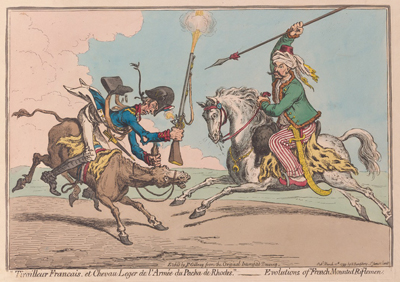Tirailleur Francais, et Chevau Leger de l'Armée du Pacha de Rhodes. . .
This is one of six prints from the series, Egyptian Sketches, created by Gillray in response to the French invasion of Egypt by Napoleon. For more information about the series as a whole, see my commentary on the title page, Egyptian Sketches.
The title can be roughly translated as "A French Sharpshooter and a Light Horseman from the army of the Pacha of Rhodes."

[March 12, 1799]
© Beinecke Rare Book and Manuscript Library, Yale University
After Nelson's victory at the Battle of the Nile cut off Napoleon from his supply route, there was a sense that the French were indeed vulnerable, and assistance again started to appear from many quarters, including the Pacha of Rhodes whose army was transported to Egypt by Sir Sidney Smith.
Like most of the Egyptian Sketches, this print is closer to the comic caricatures of Bunbury and Rowlandson than Gillray's typical satiric fare. Though grim in its subject (the French "sharpshooter" is about to be skewered by a skilled Mamaluke from the Pacha's army), the humorous treatment, as in Bunbury's Hints to Bad Horsemen (1781) and even moreso in Rowlandson's Dance of Death, allows us to laugh and take pleasure out of what would ordinarily arouse our sympathy.* Our pity is deflected by a variety of factors: the utter ungainliness of the French soldier and his recalcitrant steed, the exaggerated expressions of both human and animal, the comic contrast between the graceful horse and the awkward ass, the misfiring rifle and flying bullets from the cartridge box, and the sheer equestrian incompetence of the French soldier as he grabs the ass's ear instead of the reins.

Hints to Bad Horsemen No. 4 Symptoms of Tumbling
[May 10, 1781]
© Lewis Walpole Library, Yale University
* For a discussion of how humor can enable us to get pleasure from what should be painful, see my article, "Distance and Humor; The Art of Thomas Rowlandson," Eighteenth Century Studies, Vol 11, No. 4, pp. 457-472.
Sources and Reading
- Commentary from the British Museum on Tirailleur Francais, et Chevau Leger de l'Armée du Pacha de Rhodes.
- Thomas Wright and R.H. Evans, Historical and Descriptive Account of the Caricatures of James Gillray #226
- Thomas Wright and Joseph Grego, The Works of James Gillray, the Caricaturist; With the History of His Life and Times p. 257.
Comments & Corrections
NOTE: Comments and/or corrections are always appreciated. To make that easier, I have included a form below that you can use. I promise never to share any of the info provided without your express permission.